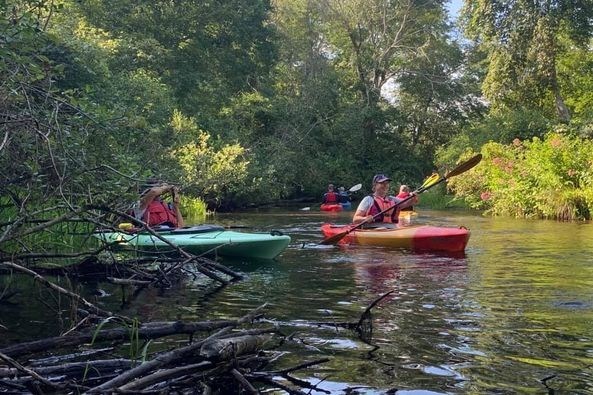Last updated: March 17, 2021
Article
Water Quality | A Look at the Water Quality of the Wood-Pawcatuck Rivers, CT/RI
The Wood-Pawcatuck Wild and Scenic Rivers Stewardship Council partnered with the Wood-Pawcatuck Watershed Association in 2020 in supporting the water quality testing of the Wood-Pawcatuck Rivers. They continue to support the testing of this vital water resource, with other stakeholders, the Salt Ponds Coalition and Save the Bay along with the community volunteers who are known as the backbone of WPWA’s water quality monitoring program. The Wood-Pawcatuck Rivers in Connecticut and Rhode Island have many testing sites throughout the region. This map shows the sites and the organizations that monitor them.
Wild and Scenic Rivers, like all rivers, are protected under the Clean Water Act, which requires states to establish water quality standards for waters within their jurisdiction. Every two years, states are required to report whether these standards are being met. In 2018, NPS compiled information from the most recent state assessments to identify the water quality status of all designated Wild and Scenic Rivers. Based on the information available at the time, NPS determined that roughly 44% of all Wild and Scenic River miles did not meet their water quality standards, with temperature, mercury, and metals being the most common causes of impairment. Want to learn more about Wild and Scenic River water quality? Read the full report found on the rivers.gov website here.

|
Wild and Scenic River |
Reporting Cycle |
Miles by Water Quality Classification |
Listed Impairments |
|
Wood-Pawcatuck Rivers |
2014 (RI), 2020 (CT) |
Good: 39.1 |
Ambient Bioassays - Chronic Aquatic Toxicity; Whole Effluent Toxicity; Benthic Macroinvertebrate Bioassessments; Non-Native Aquatic Plants; Mercury in Fish Tissue; Copper; Cadmium; Iron; Lead; Nutrients; Dissolved Oxygen; Algae; Enterococcus; Escherichia coli; Fecal Coliform |
The most significant water quality issue that the watershed faces is the excessive nutrient loading into the estuary. The Wood-Pawcatuck was designated as a Wild and Scenic Watershed. The natural, relatively undeveloped landscape of this watershed has maintained riparian buffers that help filter and reduce pollutants into the waterway. The small amount of impervious cover also reduces stormwater runoff that can also carry pollutants. According to the 2019 Wood-Pawcatuck Study Report, only 2.6% of the area in the Wood-Pawcatuck watershed is impervious and about 75% forested. According to the Wood-Pawcatuck Wild and Scenic Rivers Stewardship Plan, "Many rivers and streams in the Wood, Shunock, Green Fall, Beaver, Chipuxet, and Queen segments are found to be the highest water quality (Class A). This classification has among its designated uses potential drinking water supply and fish and wildlife habitat."
What’s next for water quality monitoring along the Wood and Pawcatuck Rivers? The WSR Stewardship Council and the Watershed Association hope to fund a project that analyzes water quality data and monitoring sites to be sure water quality management is adaptive and to create projects that support biodiversity and high quality waters.
